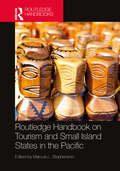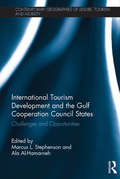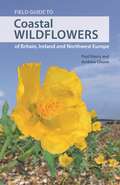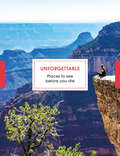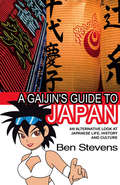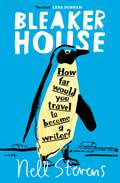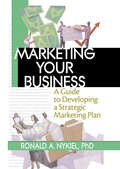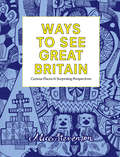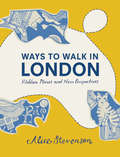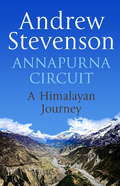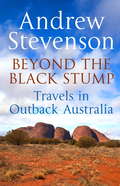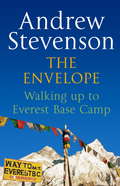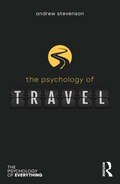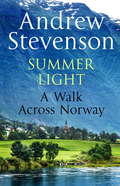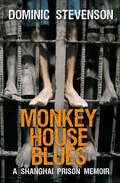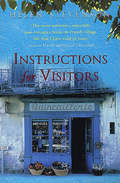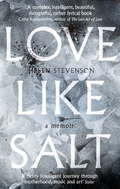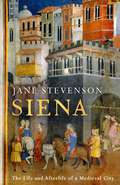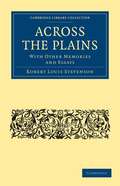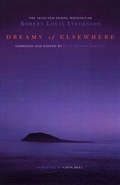- Table View
- List View
Routledge Handbook on Tourism and Small Island States in the Pacific
by Marcus L. StephensonThis timely handbook critically examines the development and role of tourism in small Pacific Island states located across Melanesia, Micronesia and Polynesia. The volume presents an expansive evaluation of current issues, challenges and potentialities for the 13 self-governing states. Interdisciplinary in coverage and borne of a varied and international authorship, this handbook incorporates 27 specifically commissioned and original contributions. Structured into four thematic sections and embellished with insightful tables and illustrations throughout, the overarching ethos of this volume is to contribute to framing the role of tourism, tourism development and the tourism industry within the context of self-governing Pacific Island states faced with the challenge of pursuing an independent path of development. In doing so, the work highlights and deciphers various tourism development perplexities in the Pacific, examining closely the intersecting sociocultural, geopolitical, environmental, organizational, operational and strategic challenges. This volume, thus, discusses a range of issues: facilitators and inhibitors of tourism growth and development; climate change, ecological concerns, and eco-tourism; non-tourism and undertourism; crisis management and the COVID-19 virus; transportation and tourism infrastructural concerns; tourism policy and planning (including tourism governance); sectoral links between tourism; food and agriculture; gender and micro-entrepreneurship; community management and participation; cultural and natural heritage sites; and the handicraft industry. The work pays critical attention to the various trajectories of sustainable tourism and the United Nations Sustainable Development Goals. Despite the many challenges and concerns raised, the book implicates the importance of good governance, progressive post-COVID-19 recovery strategies and directives, and creative and imaginative options in the successful development, re-development and advancement of tourism. As a definitive reference resource for this subject area, this handbook will be of great interest to students, researchers and academics within tourism, development studies, geography, Pacific studies, sustainability and environmental studies.
Routledge Handbook on Tourism and Small Island States in the Pacific
by Marcus L. StephensonThis timely handbook critically examines the development and role of tourism in small Pacific Island states located across Melanesia, Micronesia and Polynesia. The volume presents an expansive evaluation of current issues, challenges and potentialities for the 13 self-governing states. Interdisciplinary in coverage and borne of a varied and international authorship, this handbook incorporates 27 specifically commissioned and original contributions. Structured into four thematic sections and embellished with insightful tables and illustrations throughout, the overarching ethos of this volume is to contribute to framing the role of tourism, tourism development and the tourism industry within the context of self-governing Pacific Island states faced with the challenge of pursuing an independent path of development. In doing so, the work highlights and deciphers various tourism development perplexities in the Pacific, examining closely the intersecting sociocultural, geopolitical, environmental, organizational, operational and strategic challenges. This volume, thus, discusses a range of issues: facilitators and inhibitors of tourism growth and development; climate change, ecological concerns, and eco-tourism; non-tourism and undertourism; crisis management and the COVID-19 virus; transportation and tourism infrastructural concerns; tourism policy and planning (including tourism governance); sectoral links between tourism; food and agriculture; gender and micro-entrepreneurship; community management and participation; cultural and natural heritage sites; and the handicraft industry. The work pays critical attention to the various trajectories of sustainable tourism and the United Nations Sustainable Development Goals. Despite the many challenges and concerns raised, the book implicates the importance of good governance, progressive post-COVID-19 recovery strategies and directives, and creative and imaginative options in the successful development, re-development and advancement of tourism. As a definitive reference resource for this subject area, this handbook will be of great interest to students, researchers and academics within tourism, development studies, geography, Pacific studies, sustainability and environmental studies.
International Tourism Development and the Gulf Cooperation Council States: Challenges and Opportunities (Contemporary Geographies of Leisure, Tourism and Mobility)
by Marcus L. Stephenson Ala Al-HamarnehThis book examines the challenges facing the development of tourism in the six member states of the Gulf Cooperation Council (GCC): Bahrain, Kuwait, Oman, Qatar, Saudi Arabia and the United Arab Emirates (UAE). This region, which largely comprises the Arabian Peninsula, possesses some of the fastest growing economies in the world and is remarkably unique. It shares similar associations and affinities: tribal histories, royal kinship, political associations, Bedu cultural roots, Islamic heritage, rapid urbanization, oil wealth, rentier dynamics, state capitalist structures, migrant labour, economic diversification policies and institutional restructuring. Therefore, this volume takes the study of tourism away from its normative unit of analysis, where tourism in the region is being examined within the context of the Middle East and the wider Islamic and Arab world, towards an enquiry focusing on a specific geo-political territory and socially defined region. Although international tourism development in the region embodies a range of challenges, complexities and conflicts, which are deeply contextualized in this volume, the approach overall does not endorse the normative ‘Gulf bashing’ position that has predominated within the critical enquiries in the region. It presents a forward-looking and realistic assessment of international tourism development, examining development potentialities and constructive ways forward for GCC states and the region as a whole. This edited volume provides a real attempt to examine critically ways in which tourism and its development intersect with the socio-cultural, economic, political, environmental and industrial change that is taking place in the region. By doing so, the book provides a theoretically engaged analysis of the social transformations and discourses that shape our contemporary understanding of tourism development within the GCC region. Moreover, it deciphers tourism development’s role within the context of the GCC states undergoing rapid transformation, urbanization, ultra-modernization, internationalization and globalization. In addition to state-specific illustrations and destination case studies, the work provides insights into relatable themes associated with international tourism development in the region, such as tourism’s relationship with religion, heritage and identity, the environment and sustainability, mobility and cross-border movements, the transport industry, image production and destination branding, mega-development and political stability and instability. The book combines theory with diverse case study illustrations, drawing on disciplinary knowledge from such fields as sociology, political economy and social geography. This timely and original contribution is essential reading for students, researchers and academics in the field of tourism studies and related subject areas, along with those who have regional interests in Middle East studies, including Gulf and Arabian Peninsula studies.
International Tourism Development and the Gulf Cooperation Council States: Challenges and Opportunities (Contemporary Geographies of Leisure, Tourism and Mobility)
by Marcus L. Stephenson Ala Al-HamarnehThis book examines the challenges facing the development of tourism in the six member states of the Gulf Cooperation Council (GCC): Bahrain, Kuwait, Oman, Qatar, Saudi Arabia and the United Arab Emirates (UAE). This region, which largely comprises the Arabian Peninsula, possesses some of the fastest growing economies in the world and is remarkably unique. It shares similar associations and affinities: tribal histories, royal kinship, political associations, Bedu cultural roots, Islamic heritage, rapid urbanization, oil wealth, rentier dynamics, state capitalist structures, migrant labour, economic diversification policies and institutional restructuring. Therefore, this volume takes the study of tourism away from its normative unit of analysis, where tourism in the region is being examined within the context of the Middle East and the wider Islamic and Arab world, towards an enquiry focusing on a specific geo-political territory and socially defined region. Although international tourism development in the region embodies a range of challenges, complexities and conflicts, which are deeply contextualized in this volume, the approach overall does not endorse the normative ‘Gulf bashing’ position that has predominated within the critical enquiries in the region. It presents a forward-looking and realistic assessment of international tourism development, examining development potentialities and constructive ways forward for GCC states and the region as a whole. This edited volume provides a real attempt to examine critically ways in which tourism and its development intersect with the socio-cultural, economic, political, environmental and industrial change that is taking place in the region. By doing so, the book provides a theoretically engaged analysis of the social transformations and discourses that shape our contemporary understanding of tourism development within the GCC region. Moreover, it deciphers tourism development’s role within the context of the GCC states undergoing rapid transformation, urbanization, ultra-modernization, internationalization and globalization. In addition to state-specific illustrations and destination case studies, the work provides insights into relatable themes associated with international tourism development in the region, such as tourism’s relationship with religion, heritage and identity, the environment and sustainability, mobility and cross-border movements, the transport industry, image production and destination branding, mega-development and political stability and instability. The book combines theory with diverse case study illustrations, drawing on disciplinary knowledge from such fields as sociology, political economy and social geography. This timely and original contribution is essential reading for students, researchers and academics in the field of tourism studies and related subject areas, along with those who have regional interests in Middle East studies, including Gulf and Arabian Peninsula studies.
Field Guide to Coastal Wildflowers of Britain, Ireland and Northwest Europe (Wild Nature Press)
by Paul Sterry Andrew CleaveA richly illustrated guide to the wildflowers and other flora of coastal Britain, Ireland and Northwest EuropeThe rugged and beautiful coastal regions of Britain and Ireland are among the crowning glories of these islands. Few visitors can fail to marvel at the stunning sight of Cornwall’s clifftops resplendent with flowering Thrift, or be struck by the resilience of plants that thrive on the inhospitable shingle beaches of Dungeness on the coast of Kent. This field guide covers more than 600 species of wildflowers and other coastal flora found in Britain and Ireland, and coastal mainland Northwest Europe. Detailed species accounts describe wildflowers, grasses, sedges and rushes that occur on the coast or in abundance within sight of the sea. Stunningly illustrated throughout, this comprehensive, user-friendly guide also covers trees and shrubs, a range of other groups from mosses and seaweeds, and more broadly, the natural history of coastal habitats.Covers more than 600 species of flowering plantsFeatures over 1,500 spectacular colour photosDescribes other groups such as ferns, mosses, liverworts, lichens, fungi and seaweedsProvides up-to-date colour distribution maps for Britain and Ireland
Unforgettable Places to See Before You Die
by stevedavey.comLife is short. Take yourself to places you’ll never forget.We owe it to ourselves to see as much of this beautiful world as possible. This is for people that want to see ancient monuments, extraordinary scenery, endangered wildlife, inspiring cultures, architecture and art - places that give us the chance to grow and expand our horizons. Unforgettable Places to See Before You Die is the first title in an exciting international bestselling series of books that will help you search out essential sights and experiences around the world.International travel writer and photographer Steve Davey has drawn on his years of experience in selecting the most unmissable places to see. Some, such as the Taj Mahal and the Alhambra, are relatively well-known, but most, such as the amazing sand dunes of Dead Vlei in the Namib desert, are very much off the beaten track. All of them, though, can be visited in a holiday of two weeks or less. Beautifully illustrated with specially commissioned photographs, this is a book that will inspire you to think beyond the walls of your room and truly see the world around you.
A Gaijin's Guide to Japan: An Alternative Look At Japanese Life, History And Culture
by Ben StevensAn alternative look at Japanese life, history and culture
Bleaker House: Chasing My Novel to the End of the World
by Nell Stevens'Perfect' Lena Dunham 'This year's literary sensation' Evening StandardHow far would you travel to become a writer?8000 miles from home1085 calories a day3 months to write the novel that would make her nameAt least that was the plan. But when Nell Stevens travelled to Bleaker Island in the Falklands (official population: two) she didn’t count on the isolation getting to her . . . Hilarious and heartbreaking, this is a book about loneliness and creativity. It is about discovering who you are when there’s no one else around. And it’s about what to do when a plan doesn’t work: ultimately Nell may have failed to write a novel, but she succeeded in becoming a writer.
Marketing Your Business: A Guide to Developing a Strategic Marketing Plan
by Robert E Stevens David L Loudon Ronald A NykielExamine essential marketing disciplines and weapons!This essential book will show you how to design a strategic marketing plan for any brand, product, service, or business! It explains all of the major marketing disciplines and familiarizes you with the marketing “weapons arsenal.” It also teaches you to conduct a marketing audit, provides helpful sample worksheets and forms and includes case examples, a glossary of marketing terms, and appendixes discussing sources of “marketing intelligence” and professional marketing associations.This single volume provides a step-by-step process (with short, clear examples) of how to develop a custom plan to fit any business. In addition, it defines all of the business terms you&’ll find inside and lists additional resources to draw upon. With Marketing Your Business: A Guide to Developing a Strategic Marketing Plan, you will explore: the process of selecting the right strategy by defining your business strategy, assessing the most relevant focal points, and choosing the marketing strategy that will work best for you the arsenal of current marketing weaponry--advertising, budgeting, promotions, pricing, sales, database marketing, public relations, packaging, legal issues, and more! the nature of strategic marketing plans-competitive and environmental assessments, mission statements, slogans, budgeting, goals and objectives, etc. key checklists and 13 sample work forms that will help you formulate your plan and much more!Ideal for use by educators and students as well as businesspeople, Marketing Your Business brings together everything you need to know to develop an effective strategic marketing plan and put it into action!
Marketing Your Business: A Guide to Developing a Strategic Marketing Plan
by Robert E Stevens David L Loudon Ronald A NykielExamine essential marketing disciplines and weapons!This essential book will show you how to design a strategic marketing plan for any brand, product, service, or business! It explains all of the major marketing disciplines and familiarizes you with the marketing “weapons arsenal.” It also teaches you to conduct a marketing audit, provides helpful sample worksheets and forms and includes case examples, a glossary of marketing terms, and appendixes discussing sources of “marketing intelligence” and professional marketing associations.This single volume provides a step-by-step process (with short, clear examples) of how to develop a custom plan to fit any business. In addition, it defines all of the business terms you&’ll find inside and lists additional resources to draw upon. With Marketing Your Business: A Guide to Developing a Strategic Marketing Plan, you will explore: the process of selecting the right strategy by defining your business strategy, assessing the most relevant focal points, and choosing the marketing strategy that will work best for you the arsenal of current marketing weaponry--advertising, budgeting, promotions, pricing, sales, database marketing, public relations, packaging, legal issues, and more! the nature of strategic marketing plans-competitive and environmental assessments, mission statements, slogans, budgeting, goals and objectives, etc. key checklists and 13 sample work forms that will help you formulate your plan and much more!Ideal for use by educators and students as well as businesspeople, Marketing Your Business brings together everything you need to know to develop an effective strategic marketing plan and put it into action!
Ways to See Great Britain: Curious Places and Surprising Perspectives
by Alice StevensonDriven by curiosity, restlessness and a desire to better understand her own country, artist Alice Stevenson spent two years exploring and drawing Great Britain.With an eye for the odd and an antenna for the unexpectedly beautiful, she documented her slow, attentive forays. Her journeying was wide: steam trains in Snowdonia, art galleries on remove Scottish islands, Kent coastlines, Dorset villages, East Anglian saltmarshes, the erstwhile utopias of Harlow and Portmeirion and the wild fells of eastern Cumbria. Yet she found many hidden delights in the dense populations of cities, from Hull and Plymouth, to Belfast and Edinburgh.The result is a book celebrating detail, of landscape and architecture, and creativity, an essential human urge. A rich, artistic journey through a land deep in natural and man-made puzzles and wonders.Please note this is a fixed-format ebook with colour images and may not be well-suited for older e-readers.
Ways to Walk in London: Hidden Places and New Perspectives
by Alice StevensonAn inspiring collection of walks, notes and artworks, revealing London's multiple layers and different moods.Alice Stevenson is a Londoner who neither drives, runs nor cycles. Instead she walks, navigating the city's parks, pavements and paths daily, in all weathers. As the miles have mounted so too has Alice's knowledge of the city - the thoroughfares and the alleyways, the beauty spots and the forgotten corners. She is a unique guide with a unique eye.Whether you are walking with a purpose or walking to escape, or simply looking for new ways to appreciate the city, Ways to Walk in London is a revelation. Including walks above-ground and below-ground, waterways, pathways and the Pedway, Alice also opens our eyes to London's hidden places and pasts.Please note this is a fixed-format ebook with colour images and may not be well-suited for older e-readers.
Annapurna Circuit: Himalayan Journey
by Andrew StevensonMany disenchanted Westerners have gone to the Himalayas in search of renewal, but no one has written about the experience as perceptively and personally as Andrew Stevenson in Annapurna Circuit.A traveller all his life, Stevenson responds to people and places with an openness unique to the cultural nomad - his portraits of the men, women and children of the Annapurnas, and the fellow-backpackers from all over the world who intermittently shared his journey, are a delight; his descriptions of the landscape, and the physical hardships of the trek are enthralling. But like every travel book of real quality, this is also the result of a spiritual journey. A richly rewarding read on every level, Annapurna Circuit is a modern travel classic in the tradition of Peter Matthiesson's Snow Leopard and Andrew Harvey's Journey to Ladakh.
Beyond the Black Stump: Travels around Australia
by Andrew StevensonA seasoned traveller, travel writer Andrew Stevenson is unafraid of the unconventional. Whilst most people visiting Australia tread the well worn path from the Sydney Opera House to Cairns up the East Coast, Andrew disappeared into the Australian outback in search of the original Australians - the Aboriginal People."If you want to meet them nowadays, you've got to go beyond the black stump!" He was told. Going where few have gone before, Andrew delves into the Outback without fear. Drinking in bars with people even the locals avoid, asking questions that we all want to hear the answers to.Written with humour and compassion his powers of observation and enquiring mind draw out a frankness that is sometimes shocking but something from which we can all learn. Beyond the Black Stump: Travels around Australia is no ordinary tale of an intrepid traveller, it is an extraordinary account of an Australia that we have not seen before.
The Envelope: Walking up to Everest Base Camp
by Andrew StevensonTwelve years after his classic travel narrative Annapurna Circuit Andrew Stevenson returns alone once again to the Himalayas on a deeply personal quest, a journey both corporal and spiritual. Narrowly escaping paralysis after shattering his spine in a motorbike accident weeks after his younger brother's untimely death, Stevenson's hike up to Everest Base Camp is as much introspective passage of healing as intriguing depiction of his fellow backpackers and the Sherpa people. Lying in a hospital bed in a morphine-induced state of hallucination after his accident, Stevenson promises himself to go back to the Himalayas, to heal. Five months after his mishap, and against all the odds, this recuperative solitary climb into high mountain valleys provides a spectacular backdrop to an emotional acknowledgment and acceptance of a lost sibling. Interlaced with the hardships of pushing to the edge of personal physical endurance and beyond, The Envelope: Walking up to Everest Base Camp is a richly rewarding read on every level.
The Psychology of Travel (The Psychology of Everything)
by Andrew StevensonWhy do we travel? Are holidays good for our health? What are the social and psychological factors that drive us to move? The Psychology of Travel provides an eclectic introduction to the range of travel experiences from commuting, to going on holiday, to studying abroad. Travel is a near-universal experience and manifests itself in various forms, from everyday experiences to exotic adventure, although it varies across time and cultures. The book unpacks the concept of travel, and engages with topics including migration, wellbeing, acculturation, wayfinding, slow travel, place attachment and nostalgia, and brings them into sharp focus in relation to globalisation and climate change, By asking what drives us to journey and offering key insights into the psychological factors behind different kinds of travel, The Psychology of Travel introduces the reader to new ways of thinking about global mobility and movement.
The Psychology of Travel (The Psychology of Everything)
by Andrew StevensonWhy do we travel? Are holidays good for our health? What are the social and psychological factors that drive us to move? The Psychology of Travel provides an eclectic introduction to the range of travel experiences from commuting, to going on holiday, to studying abroad. Travel is a near-universal experience and manifests itself in various forms, from everyday experiences to exotic adventure, although it varies across time and cultures. The book unpacks the concept of travel, and engages with topics including migration, wellbeing, acculturation, wayfinding, slow travel, place attachment and nostalgia, and brings them into sharp focus in relation to globalisation and climate change, By asking what drives us to journey and offering key insights into the psychological factors behind different kinds of travel, The Psychology of Travel introduces the reader to new ways of thinking about global mobility and movement.
Summer Light: A Walk cross Norway (Journeys: Travel Literature Ser.)
by Andrew StevensonEndless summer days and vast wilderness: Norway is an outdoor paradise almost too good to be true. Andrew Stevenson's affectionate luminous account reveals the magical appeal of this Scandinavian wonderland as he walks and cycles (and gets stuck in the odd snowdrift) across the country from Oslo to Bergen Staying at clifftop farms, climbing the country's highest mountains or taking a side trip far to the north of the Arctic circle, Andrew gets under Scandinavia's skin as only someone who has lived there and speaks the language can. As he introduces a land he loves to the new love of his life, he comes to peace with a country of light-and darkness.
Monkey House Blues: A Shanghai Prison Memoir
by Dominic StevensonIn 1993, Dominic Stevenson left a comfortable life with his girlfriend in Kyoto, Japan, to travel to China. His journey took him to some of the most inhospitable and dangerous places in the world, from the poppy fields of the Afghan-Pakistan border to the ancient trade routes of the Silk Road, before he was arrested for drug smuggling while boarding a boat from Shanghai to Japan. After eight months on remand in a Chinese police lock-up, Stevenson was sentenced to two and a half years in one of the biggest prisons in the world, the Shanghai Municipal Prison aka 'The Monkey House'. There, he was imprisoned alongside just five westerners amongst five thousand Chinese criminals in a block for death row inmates and political prisoners, where the guards drank green tea and let the prison run itself. The experience led him to reflect on his previous life in Japan, India and Thailand, during which time he took on a varied array of jobs, including English teacher, karaoke-bar host, factory worker, busker, crystal seller and dope smuggler. From Afghan gun shops to Tibetan monasteries, Thai brothels and the stirrings of the rave culture in Goa, Monkey House Blues is a tale of discovery and rediscovery, of friendship and betrayal.
Instructions For Visitors: Life And Love In A French Town
by Helen StevensonIf you are lucky enough to find your place, you should never actually live in it, never make it your home. And never live with the man you think you cannot live without.Le Village is a small town at the southwestern-most tip of France. Here a young Englishwoman fell in love with France, the French and one Frenchman in particular.In her seductive, lyrical and witty memoir Helen Stevenson writes about life in Le Village, not as an expat, but as someone adopted by her neighbours as one of their own. By Stefan, the Maoist tennis fanatic, who lives off his lover in solidarity with the unemployed; by Gigi, the chic Parisian who dresses her ex-lovers' girlfriends from the stock of her exquisite boutique; and by Luc, the crumpled cowboy painter and part-time dentist, who, overcoming an aversion to blondes, takes the Englishwoman up to his remote mas, shows her his paintings and teaches her to ride.Describing the colour and light of the landscape with lyrical intensity, and savouring the languid and sexy flavour of the Mediterranean lifestyle, Helen Stevenson lays bare a romantic but potentially disastrous love affair with the man 'who seems like the only man alive to me, the one with the halo round his head in a crowd, if I should ever see him in a crowd'. INSTRUCTIONS FOR VISITORS may start as an objective guide for tenants arriving at her village house, but it ends as a very personal revelation of how difficult it can be to transplant oneself into someone else's country, someone else's culture, someone else's heart.
Love Like Salt: A Memoir
by Helen StevensonCHOSEN BY MAGGIE O'FARRELL IN THE GUARDIAN AS ONE OF HER BEST BOOKS OF THE YEAR'It's a slice of a life . . . a complex, intelligent, beautiful, thoughtful, rather lyrical book' -Cathy Rentzenbrink, author of The Last Act of Love'A moving treatise on inheritance, not just of a disease like cystic fibrosis, but of our attitudes to living and loving, our sense of cultural and familial landscape, and how these intangibles pass down through generations. Stevenson picks apart her life like a strand of DNA to uncover just how we become the sum of our parts' Daily Telegraph'A beautiful memoir . . . [Stevenson] is a novelist and a translator and her memoir is about translation in the larger sense. Translating the world is what we all do but she reminds us that one can hope - with a mind as intricately well read and original as hers - to translate misfortune; to absorb and see beyond it . . . Stevenson makes of poetry, fiction and philosophy a protective shawl for her story . . . Although intense she has a carefree wit' Kate Kellaway, Observer'Love Like Salt is a human triumph ... Ultimately, Love Like Salt follows in the hallowed footsteps of Helen MacDonald's brilliant H is for Hawk or Cathy Rentzenbrink's The Last Act of Love. These are not misery memoirs but reminders that life comes in all shades - that in the darkest moments, beauty and humour can be found' Francesca Brown, Stylist'Did Clara taste salty when I kissed her? She did. She tasted of mermaids, of the sea.'Love Like Salt is a deeply affecting memoir, beautifully and intelligently written. It is about mothers and daughters, music and illness, genes and inheritance, writing and story-telling. It is about creating joy from the hand you've been dealt and following its lead - in this case to rural France, where the author and her family lived for seven years. And back again.'I had always written, and until the birth of Clara I wrote for a living. Once I knew the Cystic Fibrosis gene had unfolded itself in our daughter's body, like a paper flower meeting water, I felt that to write, even if I had had time, or been able, would have been to squander a kind of power which was needed for tending and nurturing. Every moment became a moment in which I protected my baby. Some of it I did in secret, like a madwoman muttering spells. I thought of her as a candle, cupping my hand around her.A beautifully written memoir, in the vein of H is for Hawk and The Last Act of Love, about motherhood, music and living the best life you can, even in the shadow of illness.
Siena: The Life and Afterlife of a Medieval City
by Jane StevensonAn authoritative, richly illustrated history, and affectionate celebration, of Siena, one of the best-loved and most-visited cities in Italy. Occupying a hilltop site in the midst of a vast, undulating landscape, Siena is as much a magnet for contemporary tourism as Florence. However, its proud republican past presents an intriguing contrast with its Medici-dominated northern Tuscan rival, with which it tussled for local supremacy for much of the High Middle Ages. From the twelfth century, profiting from its advantageous position on a major pilgrim route, the Republic of Siena developed into a major European power and remained an important commercial, financial and artistic centre for four centuries. Jane Stevenson charts the changing fortunes of a city that rose to an astonishingly productive cultural heyday in the thirteenth and fourteenth centuries, suffered a catastrophic late medieval decline in the aftermath of the Black Death, but transcended the loss of its wider political power to enjoy a prosperous civic afterlife. Siena today enjoys a cherished position as a uniquely well-preserved medieval city, crammed with world-class art and architecture, furnished with appealing and intriguing traditions, and set in a heavenly landscape.
Across the Plains, with Other Memories and Essays
by Robert Louis StevensonThe celebrated Scottish writer Robert Louis Stevenson arranged for his friend the art historian Sidney Colvin to select and organise the essays in this volume, many of which had originally appeared in 1888, though some date back to the early 1880s. <P> <P> It was published in 1892, two years before Stevenson's untimely death. Colvin obtained many of the pieces from their original publishers, including magazines such as Fraser's, Longman's, The Magazine of Art and Scribner's. What is particularly noteworthy about this collection is that although Stevenson had settled in the South Seas well before it appeared, all the items included were written prior to his journey there. Colvin mentions that the concluding pieces in particular were written during a period of considerable gloom and sickness for Stevenson, who himself claimed to 'recover peace of body and mind' after moving to the Pacific in 1890.
Dreams of Elsewhere
by Robert Louis StevensonBest known for his fiction writing, Robert Louis Stevenson was also an essayist, journalist, poet and travel writer. His first major work was An Inland Voyage, an account of his journey by canoe from Antwerp to northern France. The companion work to this, Travels with a Donkey in the Cevennes (1879), is widely regarded as a travel-writing classic. June Skinner Sawyers has brought together the most comprehensive and representative sampling of Robert Louis Stevenson's prolific travel output, including excerpts from his most famous travel books, travel essays and travel poetry. The result is a collection that is as vivid and compelling as his fiction, and includes a number of lesser-known works from US collections. There are endlessly fascinating portraits of flesh-and-blood human beings, and it becomes apparent that he never grew tired of meeting new people, or of seeking new adventures. The story-teller always finds stories to tell and Stevenson was a consummate storyteller. In the tranquility of a French pine forest by moonlight he considers the importance of friendship; in a leper colony on Hawaii he reflects on physical horror and moral beauty; in all of his writing there is humanity and compasssion. Dreams of Elsewhere also features annotated listings of Stevenson historic sites, landmarks, museums, libraries, organisations, and even music inspired by Stevenson. As Gavin Bell, the critically acclaimed travel writer, states in his foreword: 'Admirers of RLS's work will welcome this judicious selection of sketches from an itinerant life. Those less familiar with his blythe spirit are in for a rare treat, a voyage of discovery with the teller of tales to where the surf murmurs on Parrot islands.'
Edinburgh: Picturesque Notes
by Robert Louis StevensonFirst published in 1879, Edinburgh: Picturesque Notes is among the most vivid of Robert Louis Stevenson’s writings. His passion for Auld Reekie never clouded his wry wit, and his enthusiasm for the picturesque detail and the savory anecdote will delight readers today as much as they scandalized his contemporaries. Perhaps best known as the author of Treasure Island and other children’s literature, Robert Louis Stevenson was a prolific novelist, playwright, essayist, and travel writer.
